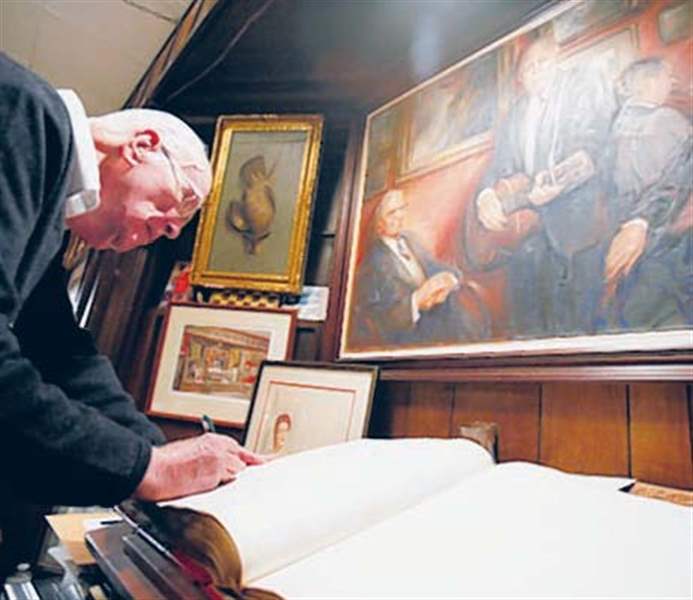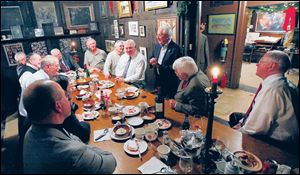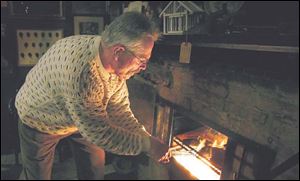
The art of friendship: Camaraderie and history come together in Tile Club
4/17/2010
Jim Brower signs the ledger at the Tile Club, which was formed in 1895.

Tile Club meetings include a steak dinner and plenty of conversation.
Since 1895, no more than 20 men have belonged to this club at any one time. Membership is selective but not arrogant; a big commitment but inexpensive.
Guided by ritual, Tile Club meetings are much as they've been for thousands of previous Tuesday evenings: thick steaks are likely to be grilled in the fireplace, portraits will be sketched, songs sung, jokes told, backs slapped, and cards dealt. After dinner, attendees' names will be recorded in the huge ledger, circa 1901.
Inside a brick clubhouse on 13th Street is a century of detritus as much absurd as sublime. It's a man cave, to be sure, but instead of a big-screen TV flanked by sports paraphernalia, the gathering room has hearth, piano, and art-covered walls. There are 11 decades of flattering member portraits, landscapes, and drawings of hunting dogs (by charter member Edmund Osthaus), along with sketches of female nudes, apparently done in the studio upstairs.
Art is the foundation of the group, and members usually have some affiliation with the arts.
“Many of the Tuesday-night discussions centered around the possibility of a museum, and the museum itself, when it finally took shape, became one of the club's primary interests,” notes a 1945 history of the Tilers' first 50 years. Indeed, they raised a substantial portion of the funds used to establish the Toledo Museum of Art, of which George Stevens, a Tiler, became the director.
Laughter, a scrumptious meal, and a few relaxing hours with friends are of paramount importance to this band of brothers. The qualifications?
“If they seem amenable to the group and tell a good joke,” says Dick Boers, who joined in 1976.
Adds Bob Boyles, of Perrysburg: “We try not to bring the world's problems in here.”
Club members have long invited guests who are female or not white, but all members are white men: that's by default, not design, says retired teacher Larry Golba, who joined in 2002.

Chris Werkman takes his turn cooking the traditional steak dinner in the fireplace at the club.
With annual dues of $500 plus a few bucks for the cook's expense, the challenge is promising to appear once a week until death do they part, and the many snowy heads here attest to member longevity.
“That's food for thought,” observes Paul LaMarre, director of the S.S. Willis B. Boyer Museum Ship. At 29, he is one of the youngest-ever Tilers. “There's nowhere in Toledo where you can have brotherhood, camaraderie, and history in one location like this.”
They begin strolling in after 5 p.m., most in suits and ties, and quickly dive into drinks, snacks, and conversation. By 6, artists drift upstairs to the studio where they'll draw, perhaps a guest. Downstairs, musicians led by pianist Jack Straub, an attorney, play and sing.
In the dining room by 7, they've clambered over wide wooden benches around the huge oak table designed by David Stine (charter member and the architect who gave us the Lucas County Courthouse, Scott and Waite high schools, and beautiful Old West End homes).

Jim Brower signs the ledger at the Tile Club, which was formed in 1895.
Wine and candles. Someone circles the table, pouring cowboy coffee from a huge white enamel pot. These walls are paneled with wooden grain chutes salvaged long ago from a grain-elevator fire and pried off the walls of the club's previous meeting place when they had to vacate it in 1955.
At feast's end, guests speak about themselves and are encouraged to tell funny stories. After cleanup and farewells, a game of rummy begins and the diehards may continue until 9:30.
The idea for the club originated with the Tile Club in New York City, a group of 31 male painters, sculptors, illustrators, and architects, including Winslow Homer and William Merritt Chase. Between 1877 and 1887, they met for fun and art, painting on ceramic tiles and taking excursions to draw. Along the way, they popularized European trends such as plein air painting and Impressionism.
Contact Tahree Lane at: tlane@theblade.com or 419-724-6075.